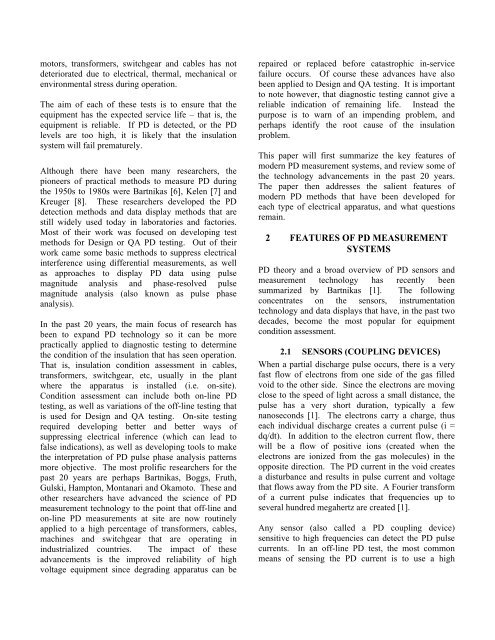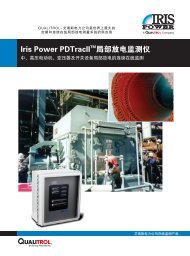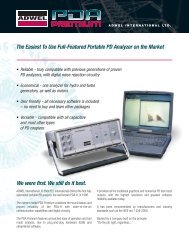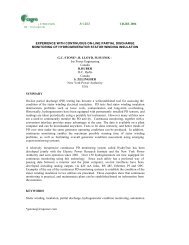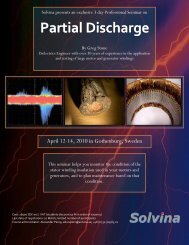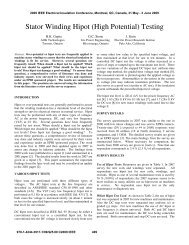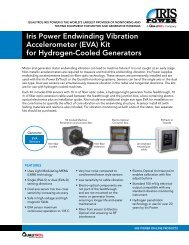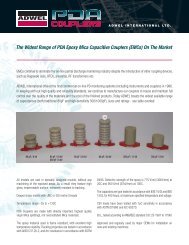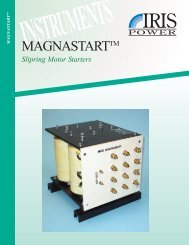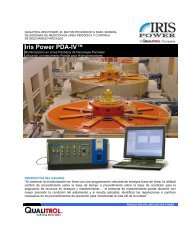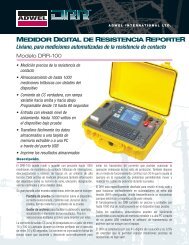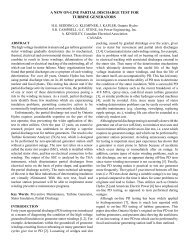Partial Discharge Diagnostics and Electrical Equipment Insulation ...
Partial Discharge Diagnostics and Electrical Equipment Insulation ...
Partial Discharge Diagnostics and Electrical Equipment Insulation ...
You also want an ePaper? Increase the reach of your titles
YUMPU automatically turns print PDFs into web optimized ePapers that Google loves.
motors, transformers, switchgear <strong>and</strong> cables has notdeteriorated due to electrical, thermal, mechanical orenvironmental stress during operation.The aim of each of these tests is to ensure that theequipment has the expected service life – that is, theequipment is reliable. If PD is detected, or the PDlevels are too high, it is likely that the insulationsystem will fail prematurely.Although there have been many researchers, thepioneers of practical methods to measure PD duringthe 1950s to 1980s were Bartnikas [6], Kelen [7] <strong>and</strong>Kreuger [8]. These researchers developed the PDdetection methods <strong>and</strong> data display methods that arestill widely used today in laboratories <strong>and</strong> factories.Most of their work was focused on developing testmethods for Design or QA PD testing. Out of theirwork came some basic methods to suppress electricalinterference using differential measurements, as wellas approaches to display PD data using pulsemagnitude analysis <strong>and</strong> phase-resolved pulsemagnitude analysis (also known as pulse phaseanalysis).In the past 20 years, the main focus of research hasbeen to exp<strong>and</strong> PD technology so it can be morepractically applied to diagnostic testing to determinethe condition of the insulation that has seen operation.That is, insulation condition assessment in cables,transformers, switchgear, etc, usually in the plantwhere the apparatus is installed (i.e. on-site).Condition assessment can include both on-line PDtesting, as well as variations of the off-line testing thatis used for Design <strong>and</strong> QA testing. On-site testingrequired developing better <strong>and</strong> better ways ofsuppressing electrical inference (which can lead tofalse indications), as well as developing tools to makethe interpretation of PD pulse phase analysis patternsmore objective. The most prolific researchers for thepast 20 years are perhaps Bartnikas, Boggs, Fruth,Gulski, Hampton, Montanari <strong>and</strong> Okamoto. These <strong>and</strong>other researchers have advanced the science of PDmeasurement technology to the point that off-line <strong>and</strong>on-line PD measurements at site are now routinelyapplied to a high percentage of transformers, cables,machines <strong>and</strong> switchgear that are operating inindustrialized countries. The impact of theseadvancements is the improved reliability of highvoltage equipment since degrading apparatus can berepaired or replaced before catastrophic in-servicefailure occurs. Of course these advances have alsobeen applied to Design <strong>and</strong> QA testing. It is importantto note however, that diagnostic testing cannot give areliable indication of remaining life. Instead thepurpose is to warn of an impending problem, <strong>and</strong>perhaps identify the root cause of the insulationproblem.This paper will first summarize the key features ofmodern PD measurement systems, <strong>and</strong> review some ofthe technology advancements in the past 20 years.The paper then addresses the salient features ofmodern PD methods that have been developed foreach type of electrical apparatus, <strong>and</strong> what questionsremain.2 FEATURES OF PD MEASUREMENTSYSTEMSPD theory <strong>and</strong> a broad overview of PD sensors <strong>and</strong>measurement technology has recently beensummarized by Bartnikas [1]. The followingconcentrates on the sensors, instrumentationtechnology <strong>and</strong> data displays that have, in the past twodecades, become the most popular for equipmentcondition assessment.2.1 SENSORS (COUPLING DEVICES)When a partial discharge pulse occurs, there is a veryfast flow of electrons from one side of the gas filledvoid to the other side. Since the electrons are movingclose to the speed of light across a small distance, thepulse has a very short duration, typically a fewnanoseconds [1]. The electrons carry a charge, thuseach individual discharge creates a current pulse (i =dq/dt). In addition to the electron current flow, therewill be a flow of positive ions (created when theelectrons are ionized from the gas molecules) in theopposite direction. The PD current in the void createsa disturbance <strong>and</strong> results in pulse current <strong>and</strong> voltagethat flows away from the PD site. A Fourier transformof a current pulse indicates that frequencies up toseveral hundred megahertz are created [1].Any sensor (also called a PD coupling device)sensitive to high frequencies can detect the PD pulsecurrents. In an off-line PD test, the most commonmeans of sensing the PD current is to use a high


